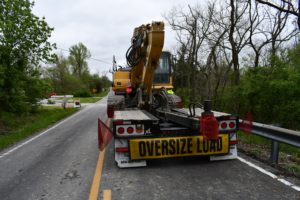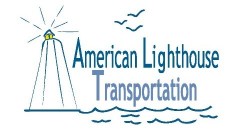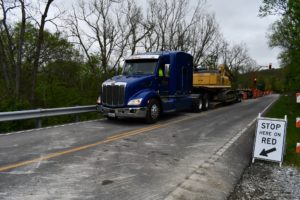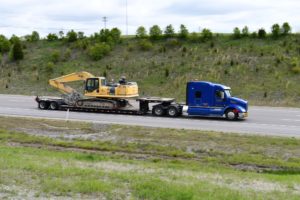 The safe and legal transportation of heavy cargo and construction equipment is no easy task. When handling some of the most massive pieces of machinery ever built by humankind, a set loading, transportation, and unloading protocol is not only a best practice… it’s the only practice. The following are what we consider then transporting large constructing equipment…
The safe and legal transportation of heavy cargo and construction equipment is no easy task. When handling some of the most massive pieces of machinery ever built by humankind, a set loading, transportation, and unloading protocol is not only a best practice… it’s the only practice. The following are what we consider then transporting large constructing equipment…
Select a Trailer to Use
Before you can begin preparing your construction equipment for transport, you will need to select the trailer on which it will ride. You can prepare your equipment properly once you know which type of trailer fits. Height usually is the problem. Most bridges and such allow you 13 1/2 feet of total clearance. If your load is too tall using a step-deck trailer, you can gain more clearance by replacing the step deck trailer with a lowboy trailer. Lowboys cost more than step-decks, so you only want to use a lowboy when you need it.
Avoiding Wide Load Designations When Possible
Only your largest pieces of construction equipment travel as wide loads. Off-road dump trucks, cranes, excavators, dozers, graders and scrapers. All are candidates for oversize designation. Tips for avoiding wide load designation include…
- Overheight – Retract, or even remove, the boom or the bucket. …
- Overweight – Shipping the body separate from the attachments reduces the weight.
- Overwidth – Not much you can do here.
- Overlength – Most states give you 53 feet in length.
Preparing the Equipment of Transport
Start chaining down heavy equipment. First, check state laws on how heavy equipment must be secured during public highway transportation. While the 4-5 tie-down points is near-universal, each state has additional oversized cargo restrictions and regulations to respect. With the heavy equipment safely positioned on the deck, you can initiate one of the most critical steps in the loading and unloading procedure – tying it down. Ask your transport representative for any special rules in the states your cargo will travel.
The owner’s manual, also known as the service manual, provides specific instructions on how to prepare and transport your equipment. Here you can find specific details, such as how to prepare the machine, secure a moving part, or tie components down. You can also find measurements and weights, which you may need for shipping purposes. The manual provides information on what to cover before transportation. You may need to disconnect the battery and alarm system to prevent an annoyance during transport. Some equipment with wheels may come with a locking mechanism to prevent sliding. A few safety tips when preparing for heavy equipment transportation…
- Prepare the Trailer for Loading – The trailer and the ramp must be clear before loading heavy equipment. Remove any debris, including leaves, rocks, rags, etc., that may clog up the area. Clean oil and lubricant off the ramp to prevent a slick surface.
- Disconnect the Battery – You want your equipment to start when you arrive. Unhook batteries so they do not get drained.
- Cover the Vulnerable Parts – When you transport heavy equipment on an open container, it’s exposed to the weather. Before you ship, cover vulnerable parts you don’t want open to wind, rain or snow. In the winter, protect the tank and lines from freezing with insulation measures. In the summer, protect machinery from overheating.
- Latch the Doors – Doors will flap in the wind if they are not properly closed. It may be best to zip tie the door shut.
- Load and Secure Equipment – Once everything is in place and covered, choose your tie-down points. Extra straps may be necessary for added security. If you are working with a hauling company, their driver will load and secure equipment following DOT regulations. Even with locking mechanisms, secure each wheel with a wedge to ensure it doesn’t move during transport. Once everything is fixed and snugly in place, it’s ready to hit the road.
Heavy equipment transportation is a serious task that’s dangerous if not performed correctly by experienced heavy trucking professionals. In the U.S., commercial vehicles makeup 4.6% registered vehicles, yet account for 10% of miles traveled. Businesses rely on commercial transportation to ship heavy equipment from one place to another. If your equipment is traveling as an oversize load, you’ll need safety banners, lights, and signs. Check with your transportation agent, they should be prepared to provide everything you need.
Example of Heavy Hauling by American Lighthouse Transportation
When construction business owners need overweight and oversize equipment moved, they call American Light House Transportation. We seamlessly arrange the shipping oversize loads and match the right equipment for the job. We plot the best path, figure your costs, and schedule your delivery. The following pictures are of American Lighthouse Transportation loading a 62,000 pound Excavator, that was oversize and overweight to Williamstown, Kentucky.
- Ready to Load
- Readying Excavator
- Loading Excavator
- Strapping It Down
- Loaded
- Leaving It Like We Found It
- On Our Way
- On The Expressway
- During the Haul
Contact Us (859) 824-4177 for more information or to get a quote!
—
 About American Lighthouse Transportation
About American Lighthouse Transportation
American Lighthouse Transportation has been serving shippers with honesty and integrity throughout the United States, since 1998. You can depend on our experienced and knowledgeable management team, drivers, and support for all your shipping needs. We communicate effectively to make sure your shipment arrives safely, accurately, and on-time! You can count on us for personalized customer service, expert guidance, accurate anticipation of potential setbacks, and possible workarounds and solutions.
>> Learn More









